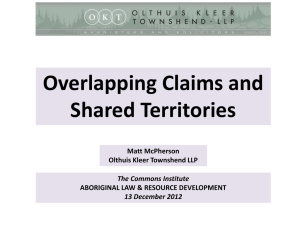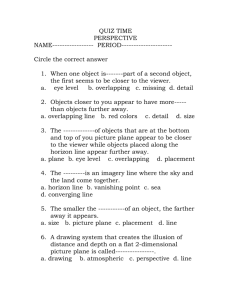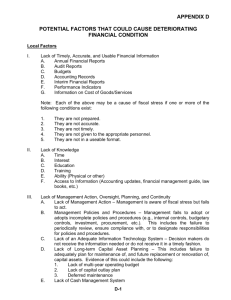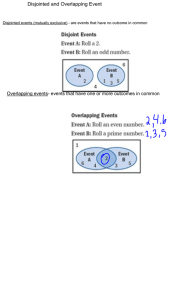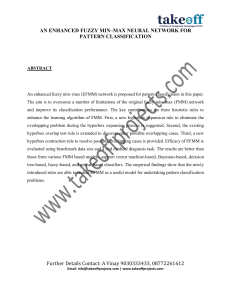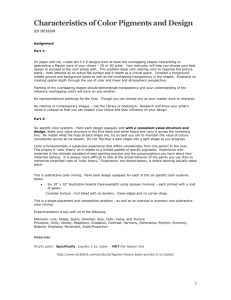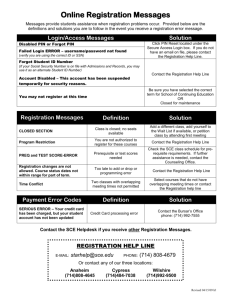Evaluating the Effectiveness of Task Overlapping as a
advertisement
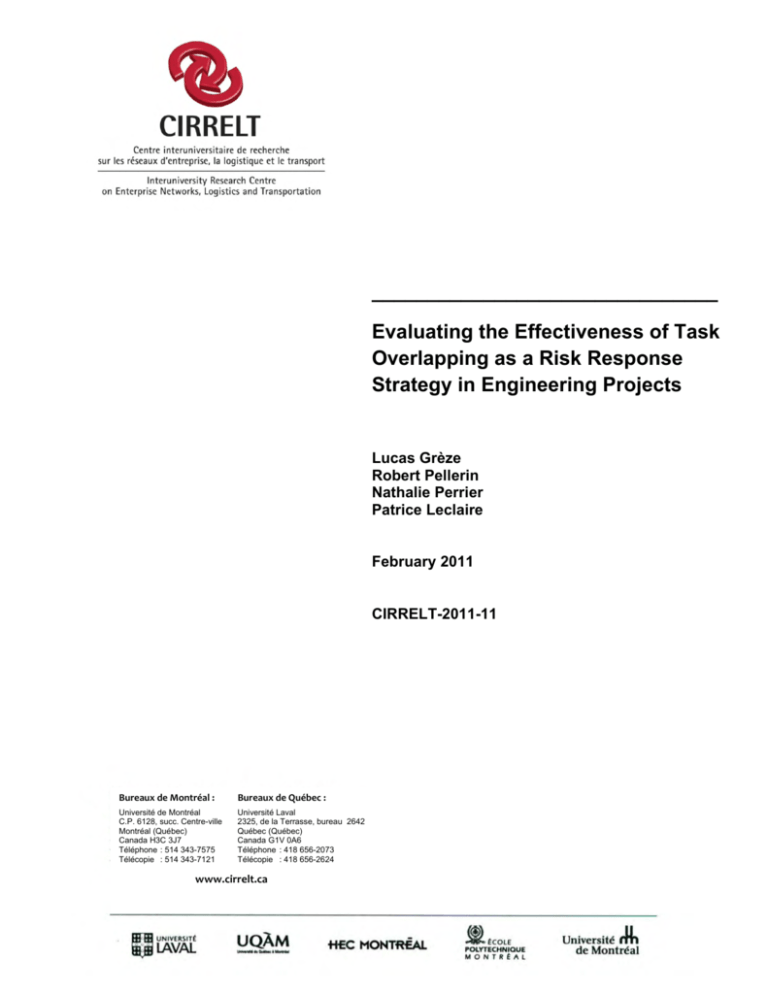
_______________________________
Evaluating the Effectiveness of Task
Overlapping as a Risk Response
Strategy in Engineering Projects
Lucas Grèze
Robert Pellerin
Nathalie Perrier
Patrice Leclaire
February 2011
CIRRELT-2011-11
Bureaux de Montréal : Bureaux de Québec : Université de Montréal
C.P. 6128, succ. Centre-ville
Montréal (Québec)
Canada H3C 3J7
Téléphone : 514 343-7575
Télécopie : 514 343-7121
Université Laval
2325, de la Terrasse, bureau 2642
Québec (Québec)
Canada G1V
G1V0A6
0A6
Téléphone : 418 656-2073
Télécopie : 418 656-2624
www.cirrelt.ca Evaluating the Effectiveness of Task Overlapping as a Risk Response
Strategy in Engineering Projects
Lucas Grèze1, Robert Pellerin1,2,*, Nathalie Perrier1,2, Patrice Leclaire3
1
2
3
Department of Mathematics and Industrial Engineering, École Polytechnique de Montréal, P.O.
Box 6079, Station Centre-ville, Montréal, Canada H3C 3A7
Interuniversity Research Centre on Enterprise Networks, Logistics and Transportation (CIRRELT)
Institut Supérieur de Mécanique de Paris (Supméca), 3 rue Fernand Hainaut, 93407 Saint-Ouen,
Cedex France
Abstract.
In the last two decades, the failure of multiple engineering projects has
highlighted the importance of adopting risk management practices.
While risk
identification and risk assessment have been widely studied in the literature, only few
authors have proposed formal tools for helping project managers to evaluate the
effectiveness of their risk response plan. While some risk response measures might be
easily validated, overlapping, a commonly used mitigation measure in engineering
projects is difficult to evaluate because of the complex interactions between activities and
resources. This paper proposes an evaluation model to measure the effectiveness of
overlapping strategy as a risk response in terms of additional cost and total maximum time
reduction. Results based on a large set of generated projects highlight the importance of
three factors in the effectiveness of an overlapping strategy: the number of opportunities
of overlapping, the maximum overlapping amount allowed, and the level of resource
constraints.
Keywords. Project management, risk management, concurrent engineering, activity
overlapping, scheduling.
Acknowledgements. This work was supported by the Jarislowsky Foundation, the SNCLavalin firm and by the Natural Sciences and Engineering Council of Canada (NSERC).
This support is gratefully acknowledged.
Results and views expressed in this publication are the sole responsibility of the authors and do not
necessarily reflect those of CIRRELT.
Les résultats et opinions contenus dans cette publication ne reflètent pas nécessairement la position du
CIRRELT et n'engagent pas sa responsabilité.
_____________________________
* Corresponding author: Robert.Pellerin@cirrelt.ca
Dépôt légal – Bibliothèque et Archives nationales du Québec
Bibliothèque et Archives Canada, 2011
© Copyright Grèze, Pellerin, Perrier, Leclaire and CIRRELT, 2011
Evaluating the Effectiveness of Task Overlapping as a Risk Response Strategy in Engineering Projects
1
Introduction
Most project schedules are developed in a deterministic manner where activity durations correspond
to a single value, usually the most likely duration. The assumption is that the duration is known with
some certainty. However, the schedule often contains significant uncertainty, especially in complex
technical environment and in new product development projects. In fact, these types of projects are
usually composed of a large number of interrelated tasks. The complexity of the information flow as
well as the possible dependency between tasks make the project scheduling difficult and unsteady.
The potential need of repeating a certain task within the development process also worsens the
situation (Chen et al. 2003).
In the last two decades, the failure of multiple engineering projects has highlighted the importance of
adopting risk management practices (Lee et al. 2009; Williams, 1995). Project risk management aims
at reducing risk by developing a project plan which minimizes the uncertainty and by implementing
strategies which maximize the probability of achieving the project goals. Various studies have
discussed means of conducting risk management by proposing formal processes for achieving project
success (Cooper et al. 2005; Patterson and Neaily, 2002; Smith and Merrit, 2002; Chapman, 1997).
While the proposed process and the terminology may differ from one author to another, the general
risk management process consists of four main phases: risk identification, risk assessment, risk
response planning, and risk control.
Among these phases, risk identification and risk assessment have been the most widely studied in the
literature. For instance, several risk analysis tools or frameworks were proposed to identify and
quantify the risks in new product development projects (Choi and Ahn 2010; Kavis et al. 2006).
Most traditional risk assessment approaches result in probabilistic analysis.
On the other hand, only few authors have proposed formal tools for helping project managers to
evaluate the effectiveness of their risk response plan, also called the risk mitigation plan. This plan,
which may include various risk avoidance, risk reduction, and risk transfer measures, is however
crucial in complex projects by formalizing the risk contingency strategy of the organization.
While some risk response measures might be easily validated, others might be more difficult to
evaluate in engineering projects. Engineering projects involve many variables and it is often difficult
to determine dependence and correlations between them. For instance, overlapping is a core
technique for reducing development time (Bogus et al., 2005; Terwiesch et al., 1999; Smith et al.,
1995; Smith and Reinertsen 1998) and is widely used as a risk response strategy when anticipating
development delay in the early phases of projects. Overlapping consists in starting an activity before
receiving all the final information required. Its efficiency for reducing product development time has
been proved in the aerospace (Sabbagh 1996) and automobile industries (Clark and Fujimoto 1991).
However, this practice often causes future rework and modification as new information is gained in
subsequent activities. In some cases, rework may outweigh the benefits of executing activities in
parallel (Terwiesch et al., 1999). The real benefits of activity overlapping also largely depend on the
nature of the project schedule as overlapping creates interactions between activities. As such, the
project topology, as defined by its network and the resource constraints may greatly affect the
effectiveness of overlapping measure. Consequently, the total expected reduction of time is difficult
to evaluate and additional costs associated with rework are often ignored in the project planning
CIRRELT-2011-11
1
Evaluating the Effectiveness of Task Overlapping as a Risk Response Strategy in Engineering Projects
phases. It is therefore not surprising to note that most companies determine overlapping strategies on
an ad hoc basis without always considering rework (Lin et al., 2009). Most contributions in the
literature also failed to consider the impact on resources when planning overlapping development
activities or are limited to measuring the project time reduction obtained through overlapping a
posteriori by analyzing completed projects (Terwiesch and Loch, 1999).
In this paper, we propose a different approach by presenting a predictive model taking into account
the interactions between activities and resource constraints. Our objective is to propose a contingency
plan evaluation model to measure the effectiveness of overlapping strategy in terms of additional cost
and total maximum time reduction. This paper is based on a deterministic resource scheduling model
which determines the optimal sets of overlappable activities and modes. The calculated project
makespan improvement can then used as an upper bound which defines the maximum gain that can
be obtained by accelerating development activities through overlapping. These results allow project
managers to determine if overlapping is an adequate risk reduction measure and what are the
additional budget requirements associated with that strategy if implemented during the project
execution.
The remainder of the paper is organized as follows. Section 2 first presents a brief review of
overlapping execution studies. Section 3 describes the proposed solution approach followed by the
description of the experimental data set used in this study in Section 4. Computational results are then
presented in section 5. The paper concludes with recommendations for future work in section 6.
2
Literature review
Overlapping depends not only on dependency between activities but also on information exchange
policy between upstream and downstream activities and progress evolution. Two groups of models
have been developed in the literature to analyze overlapping interactions. First, many authors consider
only couples of activities and no resource constraint to establish the best trade-off between
overlapping and rework. For instance, Krishnan et al. (1997) developed a model-based framework to
manage the overlapping of coupled activities. This model introduces the concept of information
evolution and downstream sensitivity to describe interaction between both activities. Information
evolution refers to the upstream generated information useful for downstream activities. Downstream
sensitivity refers to the impact of a change in upstream activity on the downstream activity. The more
significant the impact is, the higher the sensitivity is.
Relying on these concepts, Krishnan (Krishnan, 1996) defined different types of appropriated
overlapping strategies: iterative, preemptive, distributive and divisive overlapping. In a similar
manner, Bogus et al. (2006) identified appropriate strategies to efficiently implement overlapping in
practice. Lin et al. (2009) also improved the overlapping model by incorporating the downstream
progress evolution and determined the optimal overlap amount. These models assume that
overlapping parameters can be derived from historical data of projects.
Other approaches have considered whole projects instead of couples of activities under the
assumption that relation between overlap amount and rework is preliminary known for overlappable
activities. They mostly use design structure matrix (DSM) to represent dependencies, to minimize
feedbacks, and to identify overlapping opportunities between activities. DSMs were introduced by
Steward (1981). Among these models, Gerk and Qassim (2008) developed an analytic project
2
CIRRELT-2011-11
Evaluating the Effectiveness of Task Overlapping as a Risk Response Strategy in Engineering Projects
acceleration linear model via activity crashing, overlapping and substitution with resource constraints.
Wang and Lin (2009) developed a stochastic overlapping process model to assess schedule risks.
Their simulation model considers iterations and probabilities of rework. Iterations are mostly defined
as interaction between design activities which lead to rework caused by feedbacks from downstream
activities.
However, these models do not take into account resource constraints, except for Cho and Eppinger
(2005) who introduced a simulation model with stochastic activity durations, overlapping, iterations,
rework, and resource constraints for some activities. They showed that these constraints can delay
some overlapped activities and delay the project. All these models assume a simple linear relationship
between rework and overlap amount with an upper bound and a lower bound.
3
The proposed approach
A project is defined by a set of n activities, including two fictitious activities 0 and n+1, which
correspond to the project start and project end, with zero processing time. We denote by dj the
nominal processing time of activity j considering that all the final information required from
preceding activities are available at its start; in other words, if activity j is processed without
overlapping.
It is here assumed that a project is only composed of independent and dependent activities. The
resulting information flow within the project between activities is assumed to be unidirectional from
upstream to downstream activities. The analysis of information exchanges between dependent
coupled activities enables to categorize them into non- overlappable and overlappable ones. The
former represents the case where a downstream activity requires the final output information from an
upstream activity to be executed or the completion of the upstream activity. The latter represents the
case where a downstream activity can begin with preliminary information and receives final update at
the end of the upstream activity. This relation provides the opportunity to overlap two activities so
that a downstream activity can start before an upstream activity is finished. While the nonoverlappable activities are connected with the classical finish-to-start precedence constraint, the
overlappable ones are connected with a finish-to-start-plus-lead-time precedence constraint where the
lead-time accounts for the amount of overlap (Cho and Eppinger, 2005).
Figure 1 shows the overlapping process of an overlappable couple of activities i and j. The
downstream activity j starts with preliminary inputs from the upstream activity i. The amount of
overlap, αij, is expressed as a fraction of the downstream activity duration. An additional rework is
often necessary to accommodate the changes in the upstream information in the downstream
development. The expected duration of this rework is denoted by rij.
CIRRELT-2011-11
3
Evaluating the Effectiveness of Task Overlapping as a Risk Response Strategy in Engineering Projects
Figure 1: Overlapping process of two activities
di
i
Final
information
Preliminary
information
j
αij . dj
rij
dj
time
An important part of the literature on overlapping process is dedicated to the determination of the
optimal overlap amount for a couple of activities without resource constraint (Krishnan et al., 1997;
Roemer et al., 2000; Terwiesch and Loch, 1999). However, the optimal overlap amounts for a
resource-constrained project composed of several couples of overlappable activities are not
necessarily set to the optimal values found for each couple of activities (Cho and Eppinger, 2005;
Gerk and Qassim, 2008; Browning and Eppinger, 2002).
To determine the optimal schedule when overlapping is allowed, we propose a linear 0-1 integer
programming model which is based on a previous model developed by Berthaut et al. (2011). Within
this resource constraint scheduling model, presented in annex, overlapping is supposed to be
performed for discrete values of overlap amount. In practice, however, scheduling is performed on a
period by period basis and activity progress is measured according to the completion of milestones,
corresponding to activity deliverables. Therefore, we consider a finite number of different overlap
amounts aligned with activity milestones. These different values constitute the different feasible
modes. Each mode is characterized by a specific amount of overlap and associated rework duration.
In order to represent the impact of overlapping on the execution cost, the overlapping costs is
assumed to be composed of the cost of rework and the additional coordination cost. The coordination
cost is considered negligible, which is also the case in previous works (Gerk and Qassim, 2008;
Krishnan et al., 1997). It is assumed that rework cost is considered as a linear function of the time
spent on rework, where the linear factor is the average wages of the teams per unit of time. It is also
assumed that all resources have the same period rate (i.e. the resource use cost is estimated at $100
per period for all resources).
Experimental results are presented in the next section.
4
Experimental data
In order to demonstrate the importance of project characteristics, and the necessity to consider
resource constraints when evaluating the maximum time reduction that can be obtained by adopting
overlapping measures, we tested the proposed approach with different projects having similar
characteristics.
4
CIRRELT-2011-11
Evaluating the Effectiveness of Task Overlapping as a Risk Response Strategy in Engineering Projects
A reference project consisting of 30 activities was used to build our expiremtal data set. The
PROGEN project generator (Kolish et al., 1992) was used to generate comparable project networks
and resource demand. All projects involved 4 renewable resources. As in Kolisch et al. (1992), we
use three main parameters to define our project data set: the project complexity C, the resource factor
RF, and the resource strength factor RS. The complexity parameter is defined as the average number
of arcs per node. This parameter describes the complexity in relations and dependences between
activities and is used to construct the activity-on-node project networks. The resource factor is
calculated as the average portion of requested resources per activity. If RF=1, all 4 resources will be
needed for each activity. Instead, if RF=0.5, then each activity will require in average 2 different
types of resources. The quantity of each requested resource is randomly calculated between the
minimum and maximum allowed values. Finally, the resource strength factor characterizes the
relation between resource demand and resource availability. Kolish et al. (1992) present a
methodology to determine resource availability with this RS factor:
Qk = Qk ,min + Round ( RS * (Qk ,max − Qk ,min ))
where Qk,min is the minimum acceptable value for the resource k availability to complete the project,
equal to the maximum resource k request per job. Qk,max is calculated as the peak demand of resource
k in the initial makespan, without resource constraint and with earliest start schedule. Qk is the
resource k availability during the whole project. The RS factor therefore represents the influence of
resource constraints on the project.
In our design of experiment, we fixed a median value for C and RF, 2.1 and 0.5 respectively, and
generated 9 projects with similar network characteristics and resource demand. For each project, three
different characteristics of resource availability were created (RS=1, 0.75 and 0.5). Finally, 27
comparable projects without overlap data are generated (9 for each value of RS).
Three additional parameters were considered to generate overlap data. First, we set the factor R the
percentage of overlappable couples of activities among all couples of dependent activities. This factor
illustrates opportunity of overlapping, and reflects a strategy of project execution. Indeed, a project
can allow a more or less important number of couples of overlappable activities depending on the
nature of the activities and strong or flexible dependency relationship between them. In the literature,
some authors present many cases of overlapping situations, considering from 100% to 10% of
overlappable activities among all couples of activities (Gerk and Qassim, 2008). In order to present
different cases encountered in practice, three different values of R, 20%, 40% and 60% we here
considered.
The second factor Cmax is the maximum allowable amount of overlap. The value of this factor is
determined by activity milestones and previous information needed to start the downstream activity.
All overlappable activities were assumed to have similar milestones and the same maximum amount
of overlap. In the literature, authors have used various maximum of overlap (Gerk and Qassim 2008;
Wang and Lin, 2009). In this paper, three different values of Cmax were considered: 25%, 50% and
75%, which correspond to a conservative, median and aggressive possibility of overlapping
execution, respectively. Figure 2 illustrates the different modes associated to these values.
CIRRELT-2011-11
5
Evaluating the Effectiveness of Task Overlapping as a Risk Response Strategy in Engineering Projects
Figure 2: Possible values of Cmax and associated modes
The third factor β is the amount of rework per period of overlapping. This amount depends on the
nature of the project and its associated risks. This amount, set to a value of 40%, is here considered to
be the same for all activities. In practice, the project planner has to determine the amount of rework
for each overlappable activity before using an overlapping strategy, but our assumption allows to
obtain an upper bound which defines the maximum gain that can be obtained by accelerating
development activities through overlapping, and the maximum induced cost.
The three factors, R, Cmax and β were used to generate overlapping data for each project. Overlappable
couples of dependent activities are randomly selected in the list of dependent activities. An
opportunity list is established with the highest value of R. Then, for each value of R, a choice is made
randomly in this list of couples of activities. The percentage of overlappable couples is equal to the
defined value of R. Once the overlappable couples are identified, the overlap mode data is generated,
with overlap amount per mode and associated rework.
Table 1 summarizes our design of experiment. The resource strength factor RS, the percentage of
overlappable couples of activities among the total couples of dependent activities and the maximum
amount of overlapping Cmax, were all tested at three levels on 9 similar project topologies generated
with PROGEN, resulting in 243 projects.
Table 1: Variable parameter levels
5
RS
0.5
0.75
1
R
0.2
0.4
0.6
Cmax
0.25
0.5
0.75
Computational results
The 243 generated projects were implemented in AMPL Studio v1.6.j and solved with CPLEX 12.2.
Because of overlapping opportunities defined in our data generation procedure, the results in terms of
optimal time reduction vary for each project. As each project has a different initial makespan, the
effectiveness of overlapping strategy was measured as the percentage of time reduction when
comparing the calculated project makespan with overlap with the initial project schedule. Additional
costs resulting from rework in also measured in a similar manner. The resource cost is estimated at
$100 per period and we considered a $20,000 fixed cost.
6
CIRRELT-2011-11
Evaluating the Effectiveness of Task Overlapping as a Risk Response Strategy in Engineering Projects
The effects of the different parameters were analyzed by conducting ANOVA. The resulting Pareto
chart, presented in figure 3, indicates that the three factors explain 80% of variation in effectiveness
of overlapping in terms of time reduction and cost increase. The chosen factors thus have a significant
impact in overlapping effectiveness. We also observed important interaction between the percentage
of overlapping opportunities R and the maximum allowed amount of overlapping and between the
availability of resources and the two other factors. These interactions clearly show the indirect impact
of resource constraints on the effectiveness of overlapping as a risk response strategy.
Figure 3: Pareto chart of standardized effects
16,76228
R
10,24783
CMax
5,889963
RS
3,345237
R x Cmax
-3,09753
RS x RS
RS x R
2,374002
RS x Cmax
2,288307
-,955334
Cmax x Cmax
RxR
,5898599
p=,05
From figure 4, one can see the mean effect of RS in the effectiveness of overlapping strategy as a risk
response in terms of additional cost and total maximum time reduction. RS has a strong impact on
effectiveness but is not significant in terms of cost influence. Indeed, the reduction of RS decreases
the opportunity of overlapping and the resulting time gain. This is due to strong resource constraints
reducing overlapping opportunities. The large gap between RS=0.75 and RS=0.5, where the gain
varies from 8.8% to 5.8% shows the importance of resource constraints and the necessity to take them
into account when scheduling projects. Indeed, overlapping increase the impact of resource
constraints as concurrent activities may require the same resources at the same time. The time of
rework has also an impact on resource constraints as every overlapped activity requires additional
labor time due to the addition of rework.
Figure 4: RS impact in terms of time reduction and cost
Mean Plot of Gain grouped by RS
Results in Resultat.stw 12v*243c
Mean Plot of Cost grouped by RS
Mean
Mean±0,95 Conf. Interval
Results in Resultat.stw 12v*243c
11,0%
Mean
Mean±0,95 Conf. Interval
4,0%
10,0%
3,5%
9,0%
3,0%
Gain
Cost
8,0%
2,5%
7,0%
2,0%
6,0%
1,5%
5,0%
4,0%
1,0%
1,0
0,7
0,5
1,0
0,7
RS
CIRRELT-2011-11
RS
7
0,5
Evaluating the Effectiveness of Task Overlapping as a Risk Response Strategy in Engineering Projects
The impact of altering the number of overlapping opportunities R can be seen in figure 5. As R
increases, the effectiveness of overlapping increases too, from 2.5% to almost 12%. This is due to the
numerous overlapping opportunities which allow to bypass many resource constraints and finally to
decrease the time of execution of the project. The impact on cost is concave: the greater the number
of overlappable couples of activities is, the less important the influence of R on cost is. This can be
explained by the increasing number of overlap opportunities which allows small overlapping to be
efficient. This point highlights the significance of identifying correctly the couples of overlappable
activities in the risk response planning phase.
Figure 5: R impact in terms of time reduction and cost
Mean Plot of Gain grouped by R
Results in Resultat.stw 12v*243c
Mean Plot of Cost grouped by R
Mean
Mean±0,95 Conf. Interval
Results in Resultat.stw 12v*243c
14,0%
Mean
Mean±0,95 Conf. Interval
4,5%
13,0%
4,0%
12,0%
3,5%
11,0%
10,0%
3,0%
Cost
Gain
9,0%
8,0%
2,5%
7,0%
2,0%
6,0%
5,0%
1,5%
4,0%
1,0%
3,0%
2,0%
0,5%
20%
40%
60%
20%
40%
R
60%
R
The increase in the maximum overlapping factor results in a concave increase of gained time (cf.
figure 6). Significant overlapping modes allow to reduce effectively the time of execution of the
project. However, resource constraints tend to reduce the possibilities of major overlapping. On the
contrary, the impact on cost seems to be linear from 0.8% to 4%. The maximum overlap amount
allowed has a direct impact on rework time.
Figure 6: Cmax impact in terms of time reduction and cost
Mean Plot of Gain grouped by CMax
Mean
Mean±0,95 Conf. Interval
Mean Plot of Cost grouped by CMax
Results in Resultat.stw 12v*243c
5,0%
11%
4,5%
10%
4,0%
9%
3,5%
8%
3,0%
Mean
Mean±0,95 Conf. Interval
Cost
Gain
Results in Resultat.stw 12v*243c
12%
7%
2,5%
6%
2,0%
5%
1,5%
4%
1,0%
3%
0,5%
25%
50%
75%
25%
50%
CMax
75%
CMax
These computational results show that a high resource level combined with numerous opportunities of
overlapping and a high percentage of maximum overlapping favor overlapping to be an efficient risk
response strategy when anticipating project delay. The most important factor affecting the
effectiveness of overlapping as a risk response strategy is the number of overlappable couples of
activities. Resource availability has less direct impact but this factor has a high interaction with the
other factors. Finally, the maximum amount of overlapping, as well as its interaction with the number
8
CIRRELT-2011-11
Evaluating the Effectiveness of Task Overlapping as a Risk Response Strategy in Engineering Projects
of overlappable couples, is important to be considered when evaluating the effectiveness of
overlapping measures.
The most important interaction, between the number of overlappable couples and the maximum
amount of overlapping, were further analyzed by studying three scenarios. The first one is a project
with many overlappable couples of activities and a low amount of maximum overlapping. The second
one is a median one in terms of opportunities of overlapping and of maximum amount of overlapping.
The third one is a strategy with few overlappable couples and high amount of maximum overlapping.
As shown in Table 2, the first and second strategies are more effective than the third one but the
median strategy results in additional cost. This result supports the fact that the number of
overlappable activities greatly affects the effectiveness of an overlapping strategy.
Table 2: Mean impact of project characteristics in overlapping effectiveness
6
R
Cmax
Time reduction
Cost increase
60%
25%
8.4%
1.1%
40%
50%
8.3%
2.4%
20%
75%
4.6%
2.0%
Conclusion
This study shows the influence of three main factors influencing the effectiveness of adopting
overlapping as a risk mitigation measure when anticipating project delay in early phases of
engineering projects. The percentage of overlappable activities is a predominant factor of
effectiveness while having a low impact on additional cost associated with rework. Overlapping
effectiveness increases with number of overlappable activities by creating more opportunities to
resolve resource constraints, and therefore reducing the total project duration.
The maximum amount of overlapping allowed also impacts the effectiveness of overlapping
measures. However, the increase in project time reduction comes with the expense of additional work
and costs. Allowing important amount of overlapping must be studied carefully as it may create
additional risks for the project.
The impact of resource constraints on the maximum time reduction that can be obtained through
overlapping measure is another important result of this study. First, our experimental results show
that strong resource constraints greatly reduce the possibilities of overlapping as concurrent activities
may require the same resources and thus, creating resource conflicts that can be only resolved by
delaying some activities. Consequently, overlapping activities may in some cases have no impact in
total project duration. In addition, our results demonstrate that the potential benefits of overlapping
measures vary greatly from one project to another. Even when comparing similar projects, the
maximum gain in time reduction depends on the characteristics of the initial project schedule. This
result demonstrates the usefulness of the proposed approach which relies on a project scheduling
model.
CIRRELT-2011-11
9
Evaluating the Effectiveness of Task Overlapping as a Risk Response Strategy in Engineering Projects
We can also conclude that defining risk response strategies relying solely on historical data from
previous projects is not sufficient to adopt an adequate risk response plan. Risk mitigation measures
must be assessed by analyzing the impact of project resources. Historical data are however useful by
proving insights when determining the maximum amount of overlap that should be allowed and by
estimating the amount of rework associated with overlapping.
We would like also to point out some limitations of the proposed approach and suggest possible
directions for future research. First, our approach relies on an optimal scheduling model. As in most
resource scheduling approaches, computation time is an issue when analyzing real projects. In our
experiments, the number of overlapping modes has an important impact on computational time,
tending to make impossible the implementation of this upper bound analysis in practice. Future works
could develop heuristics or meta-heuristics to compare the effectiveness of different risk response
strategy as overlapping.
Secondly, we considered the impact of overlapping on total project duration and assumed that the
inherent risks of this measure can be simply taking into accounts by considering rework and its
related cost. In practice, adopting overlapping may face other risk elements, as exposed in the
concurrent engineering literature (Kayis et al., 2006). These elements must be analyzed as well.
Finally, our model calculates the maximum gain of overlapping measures from a discrete point of
view. A stochastic approach could offer a satisfactory estimation of effectiveness of overlapping,
rather than an upper bound. We have also to mention that the calculated upper bound is only feasible
at the beginning of the project. As the project progress, this maximum gain decreases. A project
rescheduling approach should be adopted within the risk control activities to continuously assess the
effectiveness of overlapping as a valid measure to respond to project delay.
References
Berthaut, F, Grèze L, Pellerin, R, Perrier, N & Hajji A 2011, ‘Optimal resource-constraint project
scheduling with overlapping modes’, submitted for International Conference on Industrial
Engineering and Systems Management.
Bogus, SM, Molenaar, KR & Diekmann, JE 2005, ‘Concurrent engineering approach to reducing
design delivery time’, Journal of Construction Engineering and Management, vol. 131, no. 11, pp.
1179–1185.
Bogus, SM, Molenaar, KR & Diekmann, JE 2006, ‘Strategies for overlapping dependent design
activities’, Construction Management and Economics, vol. 24, pp. 829–837.
Browning, TR & Eppinger, SD 2002, ‘Modeling impacts of process architecture on cost and schedule
risk in product development’, IEEE Transactions on engineering management, vol. 49, no. 4, pp.
428–442.
Chapman, C 1997, ‘Project risk analysis and management – PRAM the generic process’,
International Journal of Project Management, vol. 15, no. 5, pp. 273–281.
Chen, CH, Ling, SF & Chen, W 2003, ‘Project scheduling for collaborative product development
using DSM’, International Journal of Project Management, vol. 21, pp. 291–299
10
CIRRELT-2011-11
Evaluating the Effectiveness of Task Overlapping as a Risk Response Strategy in Engineering Projects
Cho, SH & Eppinger, SD 2005, ‘A simulation-based process model for managing complex design
projects’, IEEE Transactions on engineering management, vol. 52, no. 3, pp. 316–328.
Choi, HG & Ahn, J 2010, ‘Risk analysis models and risk degree determination in new product
development: A case study’, Journal of Engineering and Technology Management, vol. 27, pp. 110–
124.
Clark, KB & Fujimoto, T 1991, Product development performance strategy, organization and
management in the world auto industry, Harvard Business School Press, Boston, MA.
Cooper, DF, Greay, S, Raymon, G & Waler, P 2005, Project risk management guidelines: Managing
risk in large projects and complex procurements, Jown Wiley and Sons, Ltd.
Gerk, JEV & Qassim, RY 2008, ‘Project acceleration via activity crashing, overlapping, and
substitution’, IEEE Transactions on Engineering Management, vol. 55, no. 4, pp. 590–601.
Kayis, B, Arndt, G, Zhou, M, Savci, S, Khoo, YB & Rispler, A 2006, ‘Risk Quantification for New
Product Design and Development in a Concurrent Engineering Environment’, CIRP Annals Manufacturing Technology, vol. 55, no. 1, pp. 147–150.
Kolisch, R, Sprecher, A & Drexl, A 1992, ‘Characterization and generation of a general class of
resource-constrained project scheduling problems - Easy and hard instances’, Research Report 301,
Institut für Betriebswirtschaftslehre, Christian-Albrechts-Universität zu Kiel
Krishnan, V 1996, ‘Managing the simultaneous execution of coupled phases inconcurrent product
development’, IEEE Transactions on Engineering Management, vol. 43, no. (2), pp. 210–217
Krishnan, V, Eppinger SD & Whitney DE 1997, ‘A model-based framework to overlap product
development activities’, Management Science, vol. 43, no. 4, pp.437–451.
Lin, J, Chai, KH, Brombacher, AC & Wong, YS 2009, ‘Optimal overlapping and functional
interaction in product development’, European Journal of Operational Research, vol. 196, no. 3, pp.
1158–1169.
Lee, E, Park, Y, & Shin, JG 2009, ‘Large engineering project risk management using a Bayesian
belief network’, Expert Systems with Applications, vol. 36, pp. 5880–5887.
Patterson, FD & Neailey, K 2002, ‘A risk register database system to aid the management of project
risk’, International Journal of Project Management, vol. 20, no. 5, pp. 365–374.
Roemer, TA, Ahmadi, R & Wang, RH 2000, ‘Time-cost trade-offs in overlapped product
development’, Operations Research, vol. 48, no. 6, pp. 858–865.
Sabbagh, K 1996, Twenty-first century jet, Scribner, New York.
Smith, PG & Merritt, GM 2002, Proactive Risk Management: Controlling Uncertainty in Product
Development, Productivity Press, New York.
Smith, P & Reinertsen, D 1995, Developing Products in Half the Time, New York: Van Nostrand
Reinhold.
Smith, PG & Reinertsen, DG 1998, Developing Products in Half the Time, 2nd edn. John Wiley, New
York.
Steward, DV 1981, ‘The design structure system: a method for managing the design of complex
systems’, IEEE Transactions on Engineering Management, vol. 28, pp. 71–74.
CIRRELT-2011-11
11
Evaluating the Effectiveness of Task Overlapping as a Risk Response Strategy in Engineering Projects
Terwiesch, C & Loch, CH 1999, ‘Measuring the effectiveness of overlapping development activities’,
Management Science, vol. 45, no. 4, pp. 455–465.
Wang, JT & Lin, YI 2009, ’An overlapping process model to assess schedule risk for new product
development’, Computers & Industrial Engineering, vol. 57, no. 2, pp. 460–474.
Williams, T 1995, ‘A classified bibliography of recent research relating to project risk management’,
European Journal of Operational Research, vol. 85, no. 1, pp. 18–38.
12
CIRRELT-2011-11
Evaluating the Effectiveness of Task Overlapping as a Risk Response Strategy in Engineering Projects
Annex: The linear 0-1 integer program
Table 1: Symbols and definitions
Symbol
S
n
E=A∪P
i→j (i, j)
dj
A
P
A(j)
Definition
Set of activities
Number of non-dummy activities
Set of temporal or precedence constraints
Precedence constraint
Processing time of activity j
Set of couples of overlappable activities
Set of couples of non-overlappable activities
Set of immediate predecessors of activity j that are
overlappable with activity j
Set of immediate predecessors of activity j that are
P(j)
not overlappable with activity j
Pred(j) = A(j) ∪ P(j) ∀j∈ S Set of immediate predecessors of activity j
R
Rk
Rjk
mj
αijm
rjm
T
t = 0,..,T
EFj
LFj
Set of renewable resources
Constant amount of available units of renewable
resource k
Per period usage of activity j of renewable resource
k
Number of execution modes of activity j
Amount of overlap duration between activities i and
j in execution mode m, expressed as a fraction of dj
Expected amount of rework in activity j in execution
mode m
Upper bound of the project’s makespan
Periods
Earliest possible finish time of activity j
Latest possible finish time of activity j
Each activity j must finish within the time window {EF j ,..., LF j } with respect to the precedence
relations and the activity durations. They can be derived from the traditional forward recursion and
backward recursion algorithms considering that the project must start at time 0 and that T constitutes
an upper bound of the project makespan (i.e. the sum of processing times of all activities) (Hartmann,
1999). We define the decision variables (i.e. the finish times and the overlapping modes) as follows:
⎧1 if activity j is executed in mode m and finished at time t
X jtm = ⎨
⎩0 otherwise
CIRRELT-2011-11
13
Evaluating the Effectiveness of Task Overlapping as a Risk Response Strategy in Engineering Projects
[ ]
∀j ∈ S , ∀t ∈ [0, T ] and ∀m ∈ 1, m j
(1)
The decision on the activity modes can be classed into three cases. On the one hand, if activities (i,j)
are not overlappable, the decision is simply not to overlap. On the other hand, if activities (i, j) are
overlappable, these activities can be either overlapped (m > 1) or executed in series (m=1). The
resource-constrained scheduling problem with overlapping can then be formulated as a linear 0-1
mn+1 LFn+1
integer program as follows: Minimize ∑
∑t ⋅ X
n +1,t ,m
(2)
m =1 t = EFn+1
Subject to:
mi
mj
LFi
∑ ∑t ⋅ X
≤
itm
m=1 t =EFi
mj
LFj
∑ ∑(t − d
j
)
⋅ (1 − α ijm ) − r jm ⋅ X jtm
LF j
∑ ∑α
∀j ∈ S , ∀i ∈ Pred ( j )
(3)
∀j ∈ S , ∀i ∈ A( j )
(4)
∀ j ∈ S , ∀ i ∈ A( j )
(5)
∀k ∈ R ∀t ∈ [1, T ]
(6)
∀ j ∈ S , ∀ i ∈ A( j )
(7)
∀j ∈ S
(8)
m=1 t =EFj
⋅ X jtm ≤ Yij
ijm
m =1 t = EF j
⎛ mj LFj
⎞
⎜
⎟
t ⋅ X itm ≥ ⎜
t − d j (1−αijm) − rjm ⋅ X jtm ⎟ − T ⋅ (1− Yij )
⎜ m=1 t=EF
⎟
m=1 t =EFi
j
⎝
⎠
+
−
1
+
m
t
d
r
j
jm
n ⎡
⎛ j
⎞⎤
⎢ R jk ⋅ ⎜
X jbm ⎟⎥ ≤ Rk
⎜
⎟⎥
⎢
j =2 ⎣
⎝ m =1 b =t
⎠⎦
mi
LFi
∑∑(
∑∑
∑
mi
∑ ∑
mj
LFi
∑ ∑t ⋅ X
itm
≤
m =1 t = EFi
mj
)
LF j
∑ ∑t ⋅ X
jtm
m =1 t = EF j
LF j
∑ ∑X
jtm
=1
m =1 t = EF j
X jtm ∈ {0,1}
Yij ∈ {0,1}
∀j ∈ S , ∀t ∈ [0, T ] and ∀m ∈ [1, m j ] (9)
∀j ∈ S , ∀i ∈ Pred ( j )
(10)
The objective (2) minimizes the finish time of the dummy sink activity and therefore, the project
makespan. Constraint (3) represents the finish-to-start precedence constraints, with a negative lead
time in the case of overlapping. According to constraints (4), if two overlappable activities (i,j) are
overlapped, then Yij =1. If activities (i,j) are not overlapped, then Yij is unrestricted and constraints (5)
are not restrictive.
Constraints (6) define the resource constraints. Constraints (7) guarantee that the downstream activity
of a couple of overlappable activities can not finish before the upstream activity finish time.
Constraints (8) ensure that each activity is assigned one activity mode and one finish time. Finally,
constraints (9) and (10) define the aforementioned binary decision variables.
14
CIRRELT-2011-11
